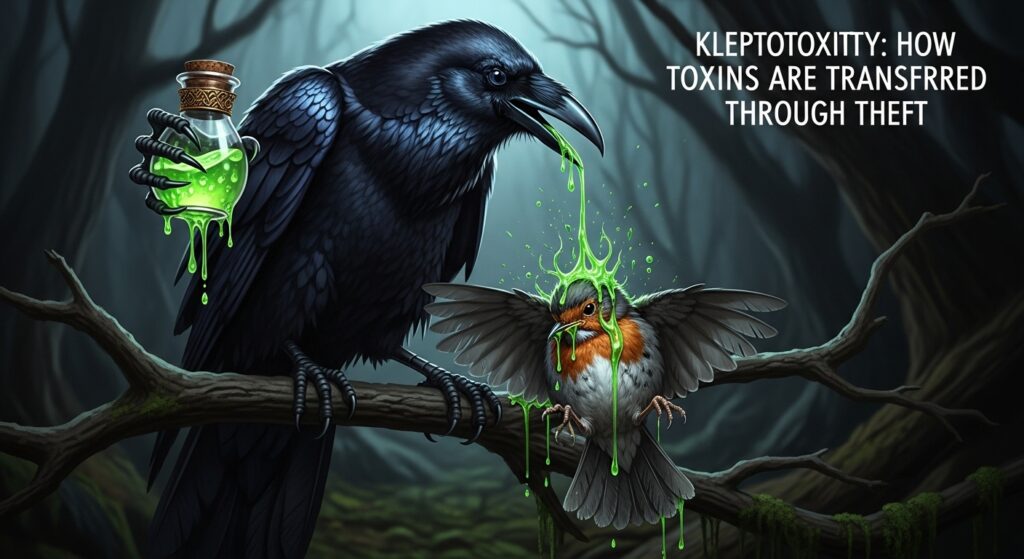Kleptotoxicity might sound like a term pulled straight from a science fiction novel, but it’s very much rooted in reality. Imagine this: what if stealing was not just about taking someone else’s belongings, but also transferring harmful substances that can affect health and well-being? This phenomenon sheds light on an unsettling connection between theft and toxins. As we dive into the intricate world of kleptotoxicity, you’ll discover how these seemingly unrelated topics intertwine and why they matter. Join us as we unravel the hidden dangers lurking behind acts of theft and explore the profound impact they can have on individuals and communities alike. The more you know about kleptotoxicity, the better equipped you’ll be to safeguard yourself against its potential harm. Let’s embark on this enlightening journey together!
The Link Between Theft and Toxins
Kleptotoxicity reveals a hidden connection between theft and toxins. When an organism steals resources, it can inadvertently introduce harmful substances into new environments.
This transfer often occurs in the animal kingdom. Certain species pilfer not just food but also toxic materials. They carry these toxins with them, affecting their new surroundings.
The implications are significant. An invader may not only disrupt local ecosystems but also spread diseases or toxins that native species cannot handle. This means that theft isn’t merely about taking; it’s about the potential harm done along the way.
Humans play a role too. Environmental pollution from illegal waste dumping is another form of kleptotoxicity, where stolen land becomes a repository for dangerous substances.
Understanding this link helps us grasp how interconnected our actions really are in both nature and society.
How Toxins are Transferred Through Theft
Kleptotoxicity reveals a startling connection between theft and the transfer of toxins. When individuals steal items, they often carry more than just physical objects; they can also transfer harmful substances.
One primary way this occurs is through contaminated goods. For example, if someone pilfers food or personal care products that harbor pathogens or chemicals, these toxins can easily find their way into new environments.
Additionally, stolen items may be tainted by the original thief’s skin contact or bodily fluids. This biological exchange creates pathways for bacteria and viruses to spread unchecked among unsuspecting victims.
Even seemingly harmless objects like clothing can pose risks when taken unlawfully. They might harbor allergens or pollutants from their previous environment, affecting anyone who comes into contact with them.
In essence, kleptotoxicity emphasizes how theft extends beyond material loss—its repercussions ripple through communities in ways we may not initially comprehend.
The Impact of Kleptotoxicity on Individuals and Communities
Kleptotoxicity can have devastating effects on both individuals and communities. When theft occurs, the repercussions extend beyond mere loss of possessions. Victims often grapple with feelings of violation and mistrust, which can alter their daily routines and interactions.
Communities are not immune to these impacts. Increased theft leads to a breakdown in social cohesion. Fear can spread among residents, fostering an atmosphere of suspicion that undermines community bonds.
Economically, kleptotoxicity takes its toll as businesses face increased security costs. Local entrepreneurs may even shutter their doors due to escalating theft-related losses.
Additionally, the psychological ramifications are profound. Anxiety and depression may surge within affected populations, leading to long-lasting emotional scars that hinder recovery efforts. Addressing kleptotoxicity is essential for restoring trust and safety in our shared spaces.
Ways to Protect Yourself from Kleptotoxicity
To protect yourself from kleptotoxicity, start by staying informed. Knowledge is your first line of defense. Understand the types of toxins that can be transferred through theft.
Be cautious about sharing personal items. Even seemingly harmless objects can carry hidden dangers. If you lend something to someone, ensure it’s clean and safe.
Establish strong community ties. A vigilant community can monitor suspicious activities and alert each other to potential risks associated with toxic transfers.
Regularly educate yourself on local crime trends or incidents related to theft and toxicity. Awareness helps in identifying patterns that may put you at risk.
Practice good hygiene when handling second-hand goods or shared belongings. Always wash items thoroughly before use, especially those frequently borrowed or taken outside your home environment.
Case Studies: Real-life Examples of Kleptotoxicity
One striking case of kleptotoxicity occurred in a coastal town where one species of crab began stealing toxins from a neighboring toxic seaweed. The crabs that engaged in this theft became poisonous themselves, affecting predators who consumed them. This caused a ripple effect through the local food chain, disrupting ecological balance.
Another example emerged within human society. In urban areas with high pollution levels, some individuals scavenged discarded items contaminated with hazardous materials. These stolen goods often ended up back on the streets or even sold at flea markets without any warning about their dangers.
In both cases, the act of theft served as a conduit for harmful substances to spread further into ecosystems or communities. This highlights how kleptotoxicity can manifest in diverse ways—affecting not only individual organisms but also entire systems and populations over time.
Understanding the Dangers of Kleptotoxicity and Taking Action to Prevent It
Kleptotoxicity represents a silent yet pressing danger in our environments. It’s the intricate web where theft leads to toxic consequences, both physical and emotional. Individuals and communities can suffer significantly as toxins spread through stolen goods or contaminated resources.
Awareness is crucial when it comes to combating this threat. Understanding how kleptotoxicity operates allows us to recognize its signs early on.
We must establish vigilant practices within our neighborhoods. Community outreach programs can educate residents about the risks associated with stolen items and their potential harm.
Protecting ourselves also means advocating for stronger policies against theft-related activities. Collaboration between local authorities and citizens fosters a safer atmosphere.
Engagement plays a key role too—encouraging open dialogues about experiences can empower individuals to take action together. Emphasizing prevention keeps everyone informed and proactive, reducing vulnerability to kleptotoxic repercussions.
Conclusion
Kleptotoxicity is an emerging concept that highlights the intersection of theft and toxins. As we explore its implications, it’s clear that understanding this phenomenon is crucial for individuals and communities alike. Theft isn’t just about taking physical items; it can also involve the transfer of harmful substances.
The link between theft and toxins reveals a darker side to criminal activities. When stolen goods are contaminated or when they carry pathogens, the repercussions extend beyond personal loss. Communities suffer as trust diminishes and health risks heighten.
Through various methods, toxins can be transferred during acts of theft. This could happen through stolen food supplies or contaminated products. Once these items circulate within a community, they pose significant health threats.
The impact on individuals can be profound—both physically and emotionally. Victims may experience not only material loss but also fear for their wellbeing. For communities, kleptotoxicity breeds distrust among residents and erodes social cohesion.
There are proactive steps one can take to protect against kleptotoxicity. Staying informed about local crime trends helps in recognizing potential threats early on. Additionally, practicing good hygiene with purchased goods ensures safety from contamination.
Real-life examples illustrate how kleptotoxicity plays out across different settings—from urban neighborhoods grappling with drug-related thefts to rural areas affected by livestock poaching carrying diseases.
As awareness grows around this issue, addressing kleptotoxicity must become a priority for everyone involved—from individuals looking out for themselves to community leaders fostering safer environments through education and collaborative efforts in crime prevention strategies.
Understanding the complexities surrounding kleptotoxicity enables us all to adopt better practices moving forward while being vigilant against potential hazards lurking behind seemingly simple acts of theft.






